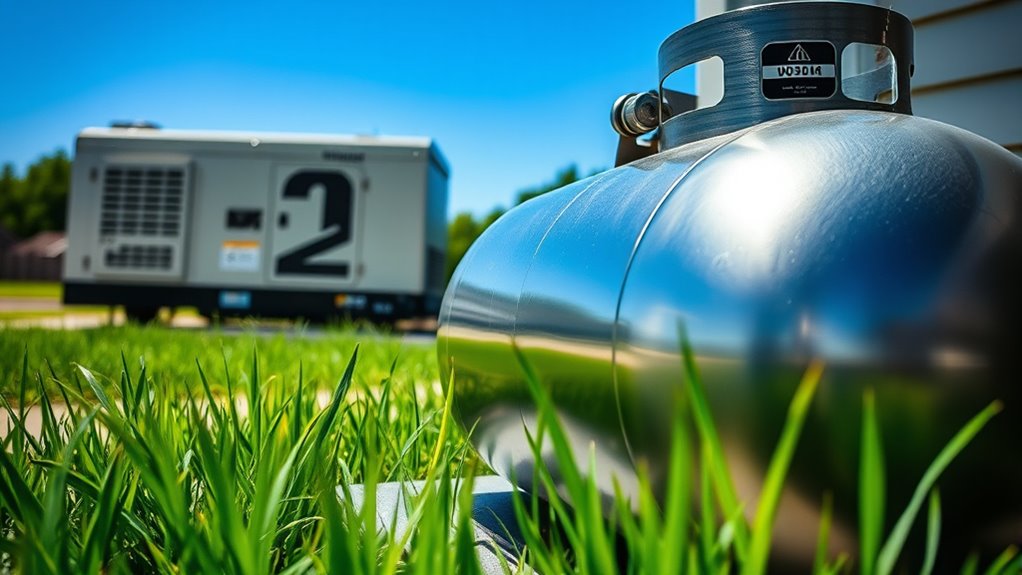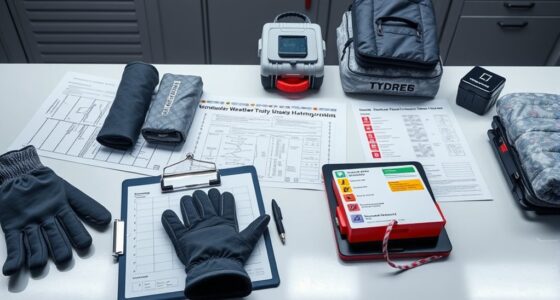To size a propane tank for your standby generator, you need to match the tank capacity with your generator’s fuel needs, considering local codes and safety limits. Proper placement, installation, and sizing guarantee safety, efficiency, and compliance with regulations from authorities like NFPA. Oversized or undersized tanks can cause safety hazards or run out of fuel. Understanding these requirements helps you choose the right tank—continue exploring to learn more about staying safe and compliant.
Key Takeaways
- Proper tank sizing ensures safe fuel supply and prevents over-pressurization, complying with safety and regulatory standards.
- Follow local codes and manufacturer guidelines for tank placement, distance from structures, and installation permits.
- Calculate generator fuel needs based on capacity and runtime to select an appropriately sized propane tank.
- Regular safety inspections verify compliance, check for leaks, corrosion, and ensure safety features are operational.
- Adhere to safety limits and regulations to avoid hazards like leaks, explosions, and legal penalties during installation and operation.
Understanding Why Proper Tank Sizing Matters
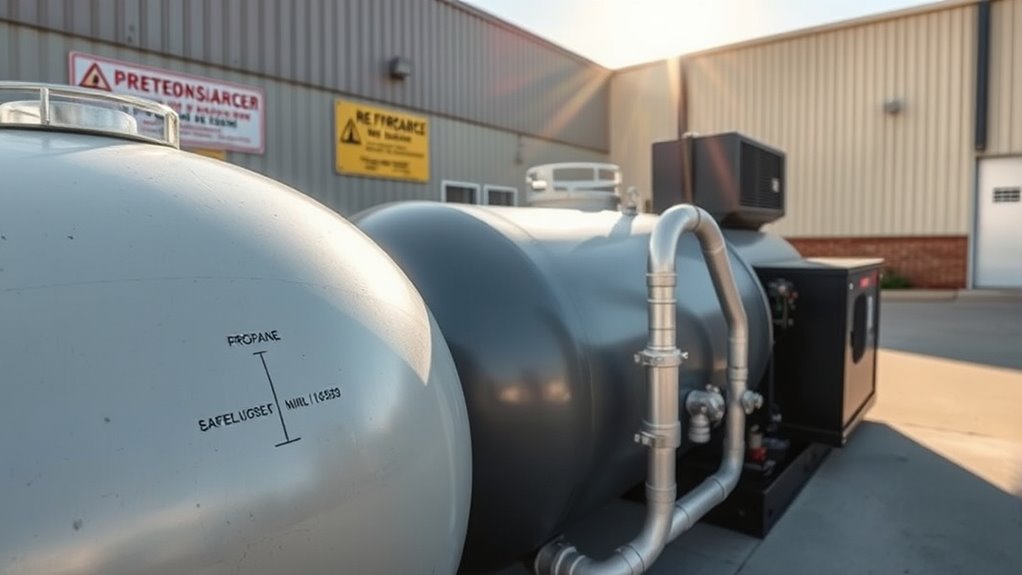
Proper tank sizing is essential because it directly impacts your propane system’s efficiency, safety, and longevity. When your tank is correctly sized, it minimizes the risk of propane leak prevention issues, reducing the chance of dangerous leaks that could compromise safety. An appropriately sized tank ensures your generator has enough fuel without overloading or causing pressure problems. This helps prevent pressure buildup and ensures consistent fuel supply during operation. Proper sizing also supports effective emergency shutdown protocols by preventing over-pressurization or fuel shortages during critical moments. Proper sizing ensures your system runs smoothly, reducing maintenance needs and extending equipment life. By choosing the right tank size, you create a safer environment, avoid costly repairs, and ensure your propane supply meets your generator’s demands reliably. Proper sizing isn’t just a recommendation — it’s a crucial part of a safe, efficient propane system.
How Generator Size Affects Propane Storage Needs
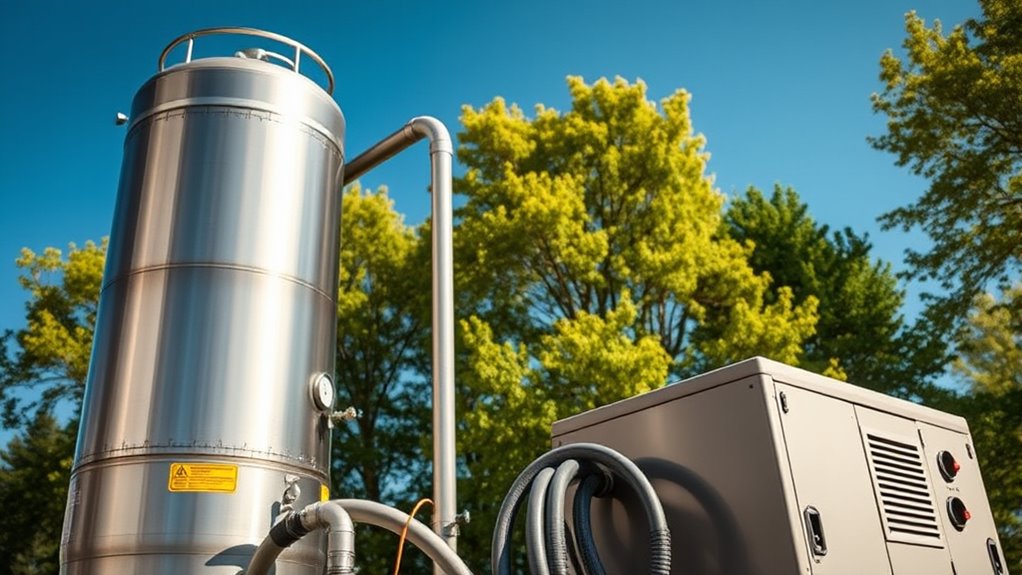
Your generator’s size directly impacts how much propane you’ll need to store. Larger generators burn more fuel, which means bigger tanks are required to run them safely and efficiently. Proper sizing helps you stay within safety limits and ensures your system remains compliant with regulations. Additionally, considering bedroom design elements can influence the placement and accessibility of your propane storage for safety and convenience.
Larger Generators Require More Fuel
As generator size increases, so does the amount of propane needed to keep it running continuously. Larger generators have higher fuel consumption rates, meaning they draw more propane to operate at full capacity. This directly impacts your storage needs, as bigger units require bigger tanks to guarantee uninterrupted power during outages. To optimize efficiency, it’s vital to match your generator’s size with your actual power needs, avoiding oversized units that waste fuel and increase storage requirements. Properly sizing your generator helps you manage fuel consumption effectively, reducing costs and ensuring reliable operation. Remember, as your power demands grow, so does your propane storage capacity, making it imperative to plan ahead for larger fuel tanks if you opt for a bigger generator. Additionally, understanding AI-powered smart city technologies can help optimize urban infrastructure and resource management.
Capacity Limits for Safety
While larger generators can provide more power, they also impose safety limits on propane storage due to potential hazards. These safety limits are designed to prevent overfilling the tank, which could lead to leaks or explosions. The fuel capacity you can store depends on local codes and manufacturer guidelines, which specify maximum amounts for safety reasons. Oversized tanks increase the risk of dangerous incidents if not properly regulated. Regulations ensure that your propane storage remains within safe limits, considering your generator’s size. Keeping fuel capacity within these safety boundaries helps minimize hazards and guarantees compliance with safety standards. Always check your local codes and manufacturer recommendations to determine the appropriate propane tank size for your standby generator. Proper storage practices are essential for maintaining safety and efficiency in your setup.
Proper Sizing Ensures Compliance
Choosing the right propane tank size is vital to guarantee your generator operates safely and efficiently. Proper sizing directly impacts compliance with codes and ensures your system meets safety standards. A generator’s size determines fuel consumption and, consequently, the required tank capacity. Using appropriate tank materials also influences safety and durability, especially for larger tanks. For example, steel tanks offer high strength, while composite materials resist corrosion. Here’s a quick reference:
| Generator Size | Fuel Efficiency | Recommended Tank Material |
|---|---|---|
| Small (10-20 kW) | High | Steel |
| Medium (20-50 kW) | Moderate | Composite |
| Large (>50 kW) | Lower | Steel or Aluminum |
| Extra Large | Varies | Custom, heavy-duty steel |
| Emergency Use | Critical | Heavy-duty steel |
Matching tank capacity to generator size ensures compliance and ideal fuel use. Ensuring proper tank sizing also helps prevent potential safety hazards and leaks.
Overview of Key Codes and Regulations for Propane Tanks
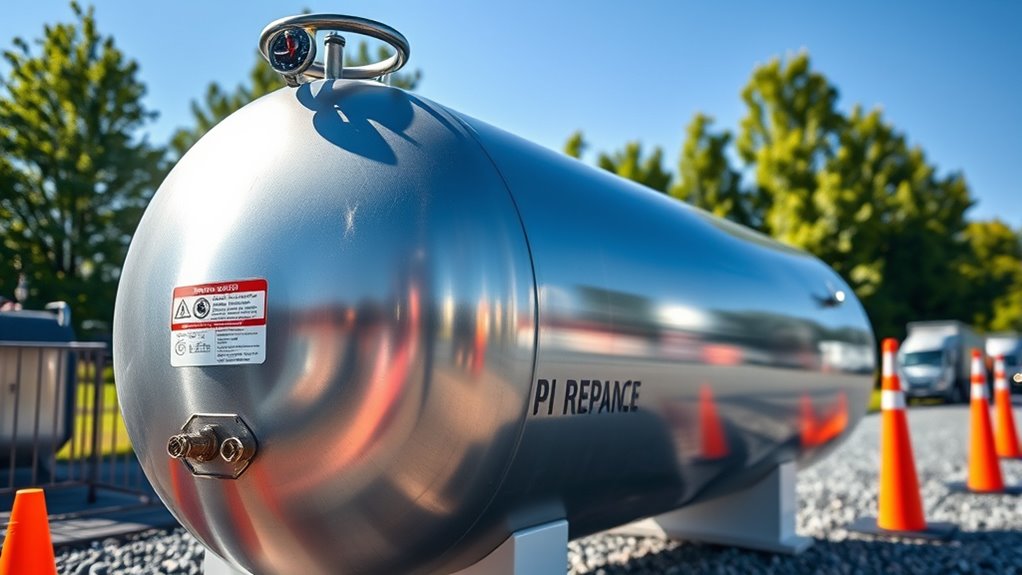
Understanding the key codes and regulations governing propane tanks is essential for guaranteeing safety and compliance. These rules specify requirements for fuel tank materials to prevent leaks and withstand environmental conditions. Usually, tanks must meet standards set by organizations like the NFPA (National Fire Protection Association) and local authorities. Installation permits are mandatory before setting up a propane tank, ensuring proper placement and safety measures. Regulations also dictate minimum distances from buildings, property lines, and ignition sources, which vary by location. Staying compliant helps avoid fines and ensures safe operation. Familiarize yourself with local codes and adhere to all safety standards during installation. Properly following these regulations keeps your setup safe, legal, and efficient for powering your generator. Additionally, understanding ethical hacking concepts can help identify vulnerabilities in your safety protocols and improve your overall compliance strategy.
Calculating the Right Tank Size for Your Generator

Selecting the right propane tank size is essential to guarantee your generator runs smoothly during power outages. To determine the proper size, consider these factors:
- Generator fuel consumption rate – know how much propane your generator uses per hour.
- Desired runtime – decide how long you want the generator to operate during an outage.
- Fuel efficiency – larger tanks improve efficiency by reducing refueling needs and maintaining consistent performance.
- Environmental impact – choosing an appropriately sized tank minimizes potential leaks and reduces overall environmental footprint.
- Understanding for sale 100 can help you compare options and find the best tank size for your needs.
Common Mistakes to Avoid When Sizing Propane Tanks
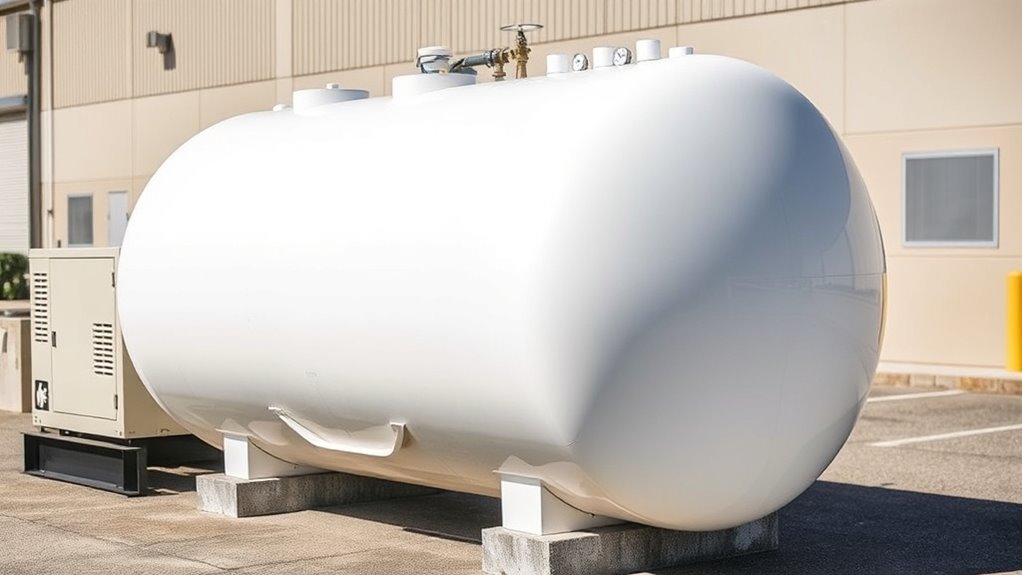
One common mistake is underestimating your generator’s fuel needs, which can leave you stranded during an outage. Avoid this by accurately calculating your propane consumption. A frequent error is choosing the wrong tank material; for example, using a tank that isn’t designed for propane or exposed to harsh conditions can cause safety risks. Additionally, selecting an improper installation location can lead to problems like poor ventilation or accessibility issues. Make sure your tank is placed in a well-ventilated, accessible spot that adheres to local codes. Oversizing or undersizing the tank can also cause problems—too small, and you’ll run out of fuel; too large, and you might be paying for unnecessary capacity. Proper sizing, suitable tank material, and correct installation location are essential for safety and efficiency.
Ensuring Safety and Compliance During Installation
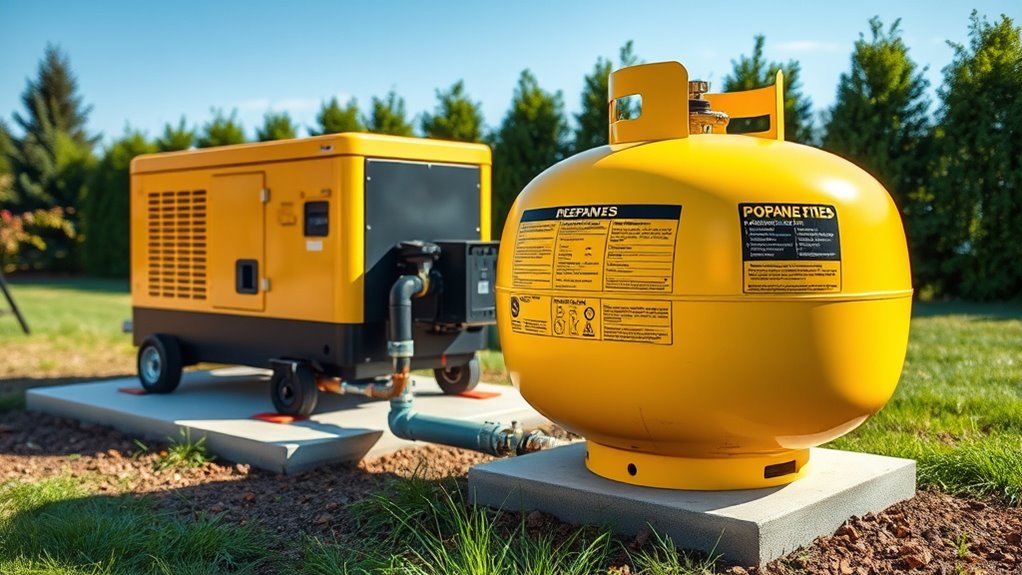
You need to follow proper installation procedures to guarantee your propane tank is safe and compliant. Regular safety inspections help catch issues early and prevent accidents. Staying vigilant during installation and maintenance keeps everyone protected. Additionally, understanding proper tank sizing for standby generators ensures your system operates safely and efficiently.
Proper Installation Procedures
Have you ever wondered why proper installation procedures are essential for propane tanks? They ensure safety, code compliance, and reliable operation. To get it right, focus on these key steps:
- Carefully plan generator placement to maintain safe distances from structures and other utilities.
- Properly install the fuel line, checking for leaks and ensuring secure connections.
- Follow manufacturer guidelines and local codes during tank positioning and securing.
- Schedule regular fuel line maintenance to prevent leaks and guarantee maximum performance.
- Understanding entertainment and parks operating hours can also help you plan your visits to ensure safety and avoid peak times during inspections or maintenance.
Regular Safety Inspections
Regular safety inspections are vital for ensuring that propane tanks remain safe and compliant throughout the installation process. During these inspections, you should check tank maintenance to identify leaks, corrosion, or damage that could compromise safety. Verify that all safety devices, like pressure relief valves, are functioning properly. Regularly reviewing emergency procedures guarantees you’re prepared if an issue arises. Inspections also help confirm that the tank placement adheres to local codes and clearance requirements. Addressing potential hazards early prevents accidents and ensures ongoing compliance. By staying vigilant with routine checks, you reduce risks and maintain a safe environment for your standby generator system. Regular inspections also provide an opportunity to check for essential safety features, ensuring your system remains protected. Consistent safety inspections are essential for peace of mind and adherence to safety standards.
Frequently Asked Questions
How Often Should Propane Tanks Be Inspected for Safety?
You should inspect your propane tank at least once a year to guarantee proper tank maintenance and safety protocols. Regular inspections help identify leaks, corrosion, or other issues that could pose safety risks. If you notice any signs of damage, schedule an inspection sooner. Additionally, follow your local codes and manufacturer recommendations, and consider professional inspections to keep your propane system safe and compliant.
What Are the Signs of a Propane Leak?
Ever wonder how to spot a propane leak? You should immediately notice the smell of propane, which is a strong, distinctive odor added for safety. Other signs include hissing sounds near the tank, dead or discolored vegetation, or a sudden drop in pressure. For gas leak detection, always listen and smell carefully, and if you suspect a leak, turn off the supply and contact professionals right away.
Can Multiple Smaller Tanks Replace a Single Large Tank?
Yes, you can replace a single large tank with multiple smaller tanks, but it depends on your total tank capacity and installation requirements. You’ll need to guarantee each smaller tank meets local codes and safety standards, including proper placement and clearance. Keep in mind that combining tanks might complicate maintenance and monitoring, so consult with a professional to make sure the setup complies with all relevant regulations and provides the necessary fuel supply.
How Does Outdoor Temperature Affect Propane Tank Sizing?
Outdoor temperature critically affects propane tank sizing because lower temperatures reduce propane vaporization, making it harder to maintain proper pressure. When it’s cold outside, your tank needs to be larger or contain more propane to ensure enough vapor for your generator’s operation. Conversely, in warmer weather, vaporization improves, and smaller tanks may suffice. Always consider outdoor temperature variations to select the right tank size for reliable standby power.
Are There Environmental Restrictions on Propane Tank Locations?
Think of choosing a propane tank location like planting a tree—environmental impact and regulatory restrictions shape where it can grow. You must follow local codes and restrictions that prevent placing tanks near water sources, property lines, or flood zones. These environmental restrictions aim to protect the environment and public safety. Always check with local authorities to make sure your tank’s placement minimizes environmental impact and complies with all regulations.
Conclusion
Getting your propane tank size right is vital for safe, reliable generator operation and staying compliant with codes. Remember, “a stitch in time saves nine”—proper planning now prevents costly issues later. By understanding your generator’s needs, following regulations, and avoiding common mistakes, you guarantee smooth, worry-free power backup. Keep safety at the forefront, and you’ll be well-prepared to weather any storm with confidence and peace of mind.
